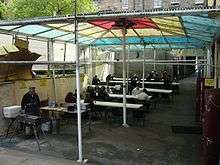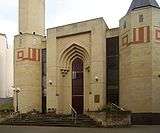Edinburgh Central Mosque
| Edinburgh Central Mosque | |
|---|---|
|
Façade of the mosque | |
| Basic information | |
| Location | Potterow, Edinburgh, Scotland, UK |
| Geographic coordinates | 55°56′42″N 3°11′10″W / 55.94500°N 3.18611°WCoordinates: 55°56′42″N 3°11′10″W / 55.94500°N 3.18611°W |
| Affiliation | Sunni |
| Website | www.edmosque.org |
| Architectural description | |
| Architect(s) | Basil Al-Bayati |
| Architectural type | Mosque |
| Architectural style | Modern that incorporates both Scots baronial and Islamic features |
| Completed | 1998 |
| Construction cost | £ 3.5 million |
| Specifications | |
| Capacity | 1300 |
| Dome(s) | 2 |
| Minaret(s) | 1 (also 3 towers on the corners) [1] |
Edinburgh Central Mosque (officially known as the King Fahd Mosque and Islamic Centre of Edinburgh) is located on Potterrow near the University of Edinburgh central area and the National Museum of Scotland. The mosque and Islamic centre was designed by Dr. Basil Al Bayati, and took more than six years to complete at a cost of £3.5m.[2] The main hall can hold over one thousand worshippers,[3] with women praying on a balcony overlooking the hall. The mosque holds chandeliers and a vast carpet, with very little furniture.
The architecture combines traditional Islamic features with some Scots baronial style.
Regarding the design, Geza Fehervari, Professor of Islamic Art & Archaeology at London University, has said "The architectural elements and decorative details, while basically relying on Islamic, mainly Turkish traditions, successfully interact with the architectural and decorative age-old customs of Scotland."[4]
History
Prior to its construction, there was no mosque large enough to fulfill the needs of the Muslims in the city centre of Edinburgh. As the Muslim population increased a large mosque became viable. Eventually, the project was able to purchase land from the City Council with the proviso that an existing listed building be preserved and used. The project ran into funding difficulties; but these were solved when King Fahd of Saudi Arabia donated 90% of the project's total cost. On 31 July 1998 (8 Rabi' al-thani 1419) the mosque was opened by his son Prince Abdul Aziz Bin Fahd, who was also the project patron.[5]
The Mosque
Main prayer hall
The main hall is where the Friday prayer (Jumu'ah) and the five daily prayers (salat) are held. There are two chandeliers, a vast carpet, and chairs for the elderly and disabled. Many short lectures and small discussion groups are held here, although such groups must give notice. The mosque also offers funeral services and the prayer Salat al-Janazah. There are two side entrances to the hall and a small glass room which also has a separate entrance/exit with a ramp for the disabled.
Ablution
There are separate ablution (wudu) rooms for both male and female. The males' contains 21 ablution washers, nine flush toilets, four Squat toilets and six sinks. As of 2010, the mosque has received additional funding and the decision has been made to upgrade the ablution facilities to accommodate more people; there will also be a separate room for the Islamic funeral process of bathing the dead body and enshrouding.
Multi-purpose hall
A second hall is located downstairs; it is much smaller than the main prayer hall. The room is sometimes opened for Friday prayers and Salat al Eid. The room is mainly used for storage but opens every year for the Islam Festival Edinburgh.
The library
There is a medium-sized library that holds a large variety of Islamic books for selling and lending. The library is opened from the morning to evening. It also holds many services such as classes in Arabic and the Qur'an as well as group discussions such as the "Brother circle", since there are two medium-sized tables and chairs.
Mosque Kitchen

The Mosque Kitchen (formerly called the Lunch Box) was opened to the public in 2004. It offers takeaway, outdoor tables and catering. The capacity is roughly 80–100. The menu consists of halal South Asian and Middle Eastern food, including various meat and vegetable curries, with rice or naan on the side. Barbecued chicken, shish kebabs and corn on the cob are also available on some days as well as barbecues on Saturdays.[6] The sitting area is specially opened at Iftar time during ramadan for the Muslims opening their fast. In August 2007, The Scotsman newspaper placed the Edinburgh Central Mosque's adjoining restaurant top of their list of Best Festival Food.[7] In Summer 2011, the team who originally ran the Mosque Kitchen left amidst a dispute with the mosque and moved to a more conventional restaurant on Nicolson Square (still called the Mosque Kitchen[8]); the kitchen at the mosque is now run under separate management and operates as 'The Original Mosque Kitchen and Café'.[6]
Islam Festival Edinburgh
The Islam Festival Edinburgh (IFE, and also known as the Discover Islam Exhibition) is part of the Edinburgh Festival. It is held in this mosque during the entire month of August every year. The mosque is opened to the public.
The exhibition is held in the multi-purpose hall where Muslims and non-Muslims are welcome. There are posters that teach about specific Islamic topics, such as Islamic art, Qur'an translation, and so on.
Usually special events are held on Saturdays, such as classes on Arabic calligraphy and presentations of Arabic art. There are also lectures from various speakers, some of whom, such as Farkhanda Chaudhry, come back each year. For example, in 2007 Chaudhry gave a talk on "Women and Islam" and in 2009 he spoke on "Women, Islam and Liberation". Similarly, Idris Tawfiq has presented "Who's afraid of Sharia law?" and "The Muslim Jesus" several times. Well-known people have visited the exhibition, including the First Minister's advisors, and MPs including Sir Menzies Campbell.[9]
Gallery
| Wikimedia Commons has media related to Edinburgh Central Mosque. |
 Front entrance of the mosque
Front entrance of the mosque Snow in December 2009
Snow in December 2009 Back entrance of the Mosque
Back entrance of the Mosque
See also
External links
- Basil Al Bayati Official website of architect
References
- ↑ "Colour Correction". Retrieved 2008-07-26.
- ↑ Edinburgh mosque opens "BBC new report" Check
|url=value (help). 1998-07-31. Retrieved 2008-07-02. - ↑ "Muslim Directory". Retrieved 2008-07-02.
- ↑ Fehervari, Geza (9 June 1989). "Faith in Tradition" (No. 940 ed.). Building Design magazine. p. 26.
- ↑ "Bryophytes and Buildings of the Southside". Retrieved 2008-07-26.
- 1 2 "The Original Mosque Kitchen by The List". Retrieved 2012-01-06.
- ↑ "Article on Kitchen". Retrieved 2008-07-02.
- ↑ "Mosque Kitchen by The List". Retrieved 2012-01-06.
- ↑ "Islam Festival Edinburgh". Retrieved 2008-07-28.
